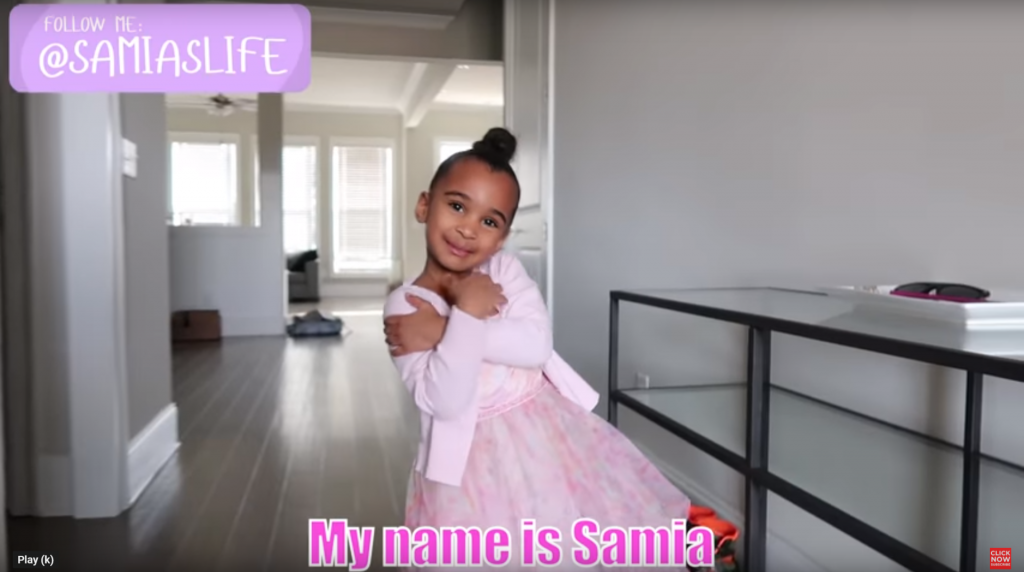
Image source: YouTube
As brands seek youthful social media influencers to promote their merchandise, so-called kidfluencers seem to be getting younger and younger.
A recent article in The New York Times portrayed 4-year-old Samia Ali who has 143,000 followers on Instagram and 203,000 subscribers on YouTube. Samia grew up on social media. Her parents, Adam and LaToya Ali, who are influencers themselves, related Samia’s approaching arrival on YouTube
In another family, 2-year-old identical twins Taytum and Oakley Fisher have more than two million Instagram followers. The family’s YouTube channel has about three million subscribers. In what’s likely the record for the youngest kidfluencer, the parent’s third child gained 112,000 followers before being born.
Major companies like Walmart, Staples and Mattel pay thousands of dollars for sponsored posts to promote toys and other children’s merchandise on kidfluencer’s social media accounts. Brands also offer smaller amounts or free products to those with mid-sized followings. Last summer, the toy company Melissa & Doug offered parents payments and free toys for weekly Instagram posts. The company, the Times noted, offered $10 per 1,000 followers for individual posts and $5 per 1,000 followers for Instagram Story posts.
The Issue with Kidfluencer Marketing
Consumer advocates see a problem with such kidfluencer marketing. Social media sites like YouTube, Instagram and Facebook are not meant for children. The rules say users must be 13 years old or more to create accounts. Networks require kidfluencer accounts to state that they’re run their parents.
The Children’s Online Privacy Protection Act (COPPA) requires companies to obtain parental consent to collect data that could be used to identify, contact or locate a child. That includes photos, video, audio and the location of a child’s mobile device.
Anyone who watches YouTube affirms that they’re at least 13 years old and agrees to Google’s privacy policy that allows in-depth data collection. YouTube has a stand-alone app for younger children, YouTube Kids, that shows filtered of videos from the main site and enforces a stricter privacy policy.
Social media analytics seem to show that women in their 20s and 30s compose the main audience of kidfluencers. But some kidfluencer parents told the Times they believe viewers are mostly under 18. Why the discrepancy? Children watch on their parents’ devices.
Critics say YouTube knowingly collects extensive data about children. Sponsored posts of kidfluencers opening toy boxes or playing with toys clearly target children. Such ads can deceive children, who are especially gullible to ads.
Special Oversight for Kidfluencer Marketing
As concerns about privacy grow, complaints and calls for increased regulation are likely to increase. Kidfluencer marketing requires special precautions and careful oversight in order to work effectively and protect the sponsoring brand’s reputation. Clear disclosures, family-friendly content, and views of parents become paramount.
“When it comes to creating content for kids, it’s essential for parents to feel confident that what they’re seeing is kid-friendly and authentic. Safety and transparency should be keywords for brands exploring this arena,” advises Emilie Tabor, co-founder and chief marketing officer at influencer marketing agency IMA, in Adweek.
Bottom Line: Companies can increase brand awareness and boost sales by partnering with child social media influencers and their parents. However, brands may face growing reputational risks due to ethical and legal complaints. Regulatory attention aimed at advertisers and social media networks may increase as privacy concerns increase. Kidfluencer marketing must embrace strict precautions to avoid damaging the brand reputation.
William J. Comcowich founded and served as CEO of CyberAlert LLC, the predecessor of Glean.info. He is currently serving as Interim CEO and member of the Board of Directors. Glean.info provides customized media monitoring, media measurement and analytics solutions across all types of traditional and social media.




